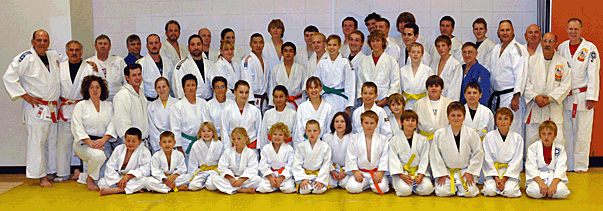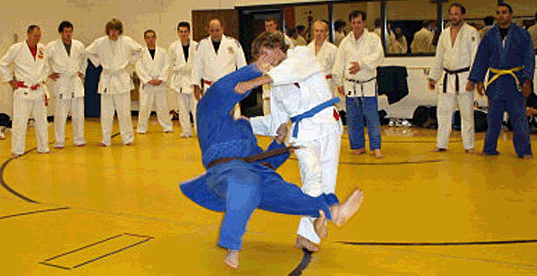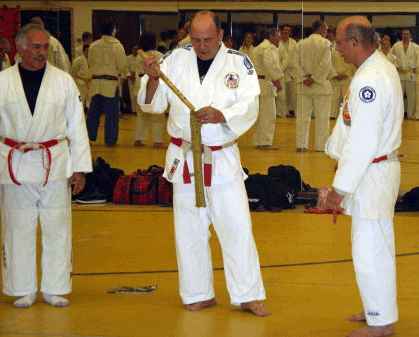
Steven Point Journal - November 11, 2011
National Judo President Offers Local Clinic
by Tom Gustin

Gary Goltz (on far left) with the clinic attendees
On Nov. 8, Gary Goltz, United States Judo Association (USJA) president, was in Stevens Point for a judo clinic.
The clinic was hosted by the University of Wisconsin-Stevens Point Judo Club and the Stevens Point Judo Club. About 60 judo students came from around the state to listen and learn from the national president. They ranged in age from 6 to 78. Some participants took notes while parents took pictures or video of their children in the clinic.
Sensei (teacher) Goltz started judo when he was 10 years old at the Jewish center in Pittsburgh, Pa. At age 14, he used his judo training to subdue two attackers. At age 16, Goltz began teaching judo at several YMCAs in Pittsburgh. He was awarded his first-degree black belt when he was 21. He went on to become judo chairman for the Allegheny Mountain Region of the Amateur Athletic Union (AAU). Currently, he holds a seventh-degree black belt and is a regular contributor to Black Belt Magazine. Goltz graduated with a bachelor's degree cum laude from the University of Pittsburgh in 1976.
Moving to southern California, he started Goltz Judo in 1987, which has been the largest club for more than a decade of the 25,000 Judokas in the United States. He currently serves as president and CEO of the USJA. Goltz coached the U.S. Blind Judo Team at the 1991 Tokyo World Championship. In 1997 he was invited to be the defensive tactical adviser to the Los Angeles Police Department. He started Judo Winter Nationals in 2006, uniting the USJA with the United States Judo Federation (USJF), a rival in judo for many years. Today this event draws more than 600 competitors.
Goltz started the clinic with a variety of stretching exercise working the neck and back. After everyone was warmed up, Goltz explained the basic falling (ukemi) skills. He said "knowing how to fall properly, you have the confidence to be thrown and not worry about injuries."
Next he explained that boxers are trained to keep their elbows in. Judo students are told to keep their elbows in also. With elbows in next to the body, the response time for throws, counters and defense is much faster. For example, law enforcement officers are trained to keep elbows next to the body when talking with individuals and just outside the personal space of the individual. The officer learns to read body language for that edge. The judo student keeps his elbows next to his body as well and works inside that personal space of the individual. The judo student must learn to read muscle tensing along with body movement in order to defend, counter or throw an opponent. The main idea is to keep elbows next to the body for a faster response and practice, practice, practice.

Student demonstrates a foot sweep taught by Sensei Goltz
Goltz demonstrated the next stage of the clinic to crafting a basic foundation; it was a drill he picked up from the French. Partners faced each other with their hands on each other's shoulders. The students took turns moving left and right, trying to develop a sense of timing. In the next step, students took turns moving outside of the opponent's legs both to the left and right leg. Then he had the students move in between their partner's leg. Then he had students pivot in front of the partner, doing a 180-degree turn to face in the same direction as their partner to do a forward throw. While doing these drills their hands had to remain on their partners' shoulders. This drill helped to develop a solid foundation to perfecting throws, counters, combinations and defense movements.

Tom Gustin (far right) presenting Sensei Goltz with a handmade flute
Goltz received a round of applause and a handmade bamboo flute from the UWSP Judo Club and the Stevens Point Judo Club.